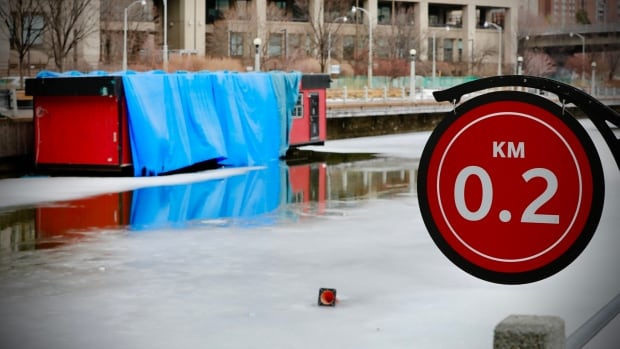The Rideau Canal Skateway will not open this winter, making this season the first one ever without the popular pastime and tourist draw.
The National Capital Commission (NCC) said Friday afternoon the closure is disappointing, but the weather didn’t co-operate.
“This winter’s higher-than-average temperatures, snow and rain … contributed to a thin and porous ice surface,” it tweeted.
“The latest ice tests show that the ice surface remains unsafe. Any further efforts are unlikely to yield a different result.”
This winter in Ottawa has been one of the warmest in decades, with more than 250 centimetres of snow falling as of Friday — weather conditions poorly suited to the formation of thick, smooth ice.
The NCC first dispatched a team of workers armed with brooms and shovels to clear a short section of the frozen waterway for skating in 1971. This year is the first time the skateway hasn’t opened since then.
The capital’s annual Winterlude festival, which ended Monday, did not have one of its major attractions for the first time ever.
Until now, the shortest skating season on the canal was in 2016, when the skateway was open for just 18 days. The latest opening day was Feb. 2, 2002.
Last winter, the entire 7.8-kilometre length of the skateway opened in mid-January and lasted 41 days until early March.

The NCC bills it as the world’s largest skating rink, calling it “an iconic and beloved attraction” as it closed the door on its chances for the season.
“We already look forward to welcoming visitors to the world’s largest skating rink next winter.”

Canal’s future on this ice
As winters in Ottawa grow warmer and wetter, the NCC has been experimenting with new ice-making methods, and has also updated and bolstered its climate change strategy.
“This year taught us a great deal about the effects of milder winters on the Skateway … [We] remain committed to applying what we learn going forward,” it said in Friday’s news release.
According to a long-term risk assessment commissioned by the NCC, the warmer weather has shortened the average skating season on the UNESCO World Heritage site by about four days per decade, typically at the start.
According to the report, February starts could become the norm, while skating seasons of 40 days or more will become the exception by 2050. (The report’s authors didn’t dwell on the possibility that the skateway might remain closed altogether.)
By comparison, about four-fifths of the skating seasons between 1981 and 2010 lasted at least 40 days before the spring melt set in.
“In the long term, the NCC should determine the threshold for which investing in maintaining the ice surface will exceed the benefits provided, and consider diversification of winter programming surrounding the canal,” the report said.
It mentions the possibility of hosting concessions and other winter activities such as cross-country skiing next to the canal on the NCC’s pathways and Queen Elizabeth Driveway.


